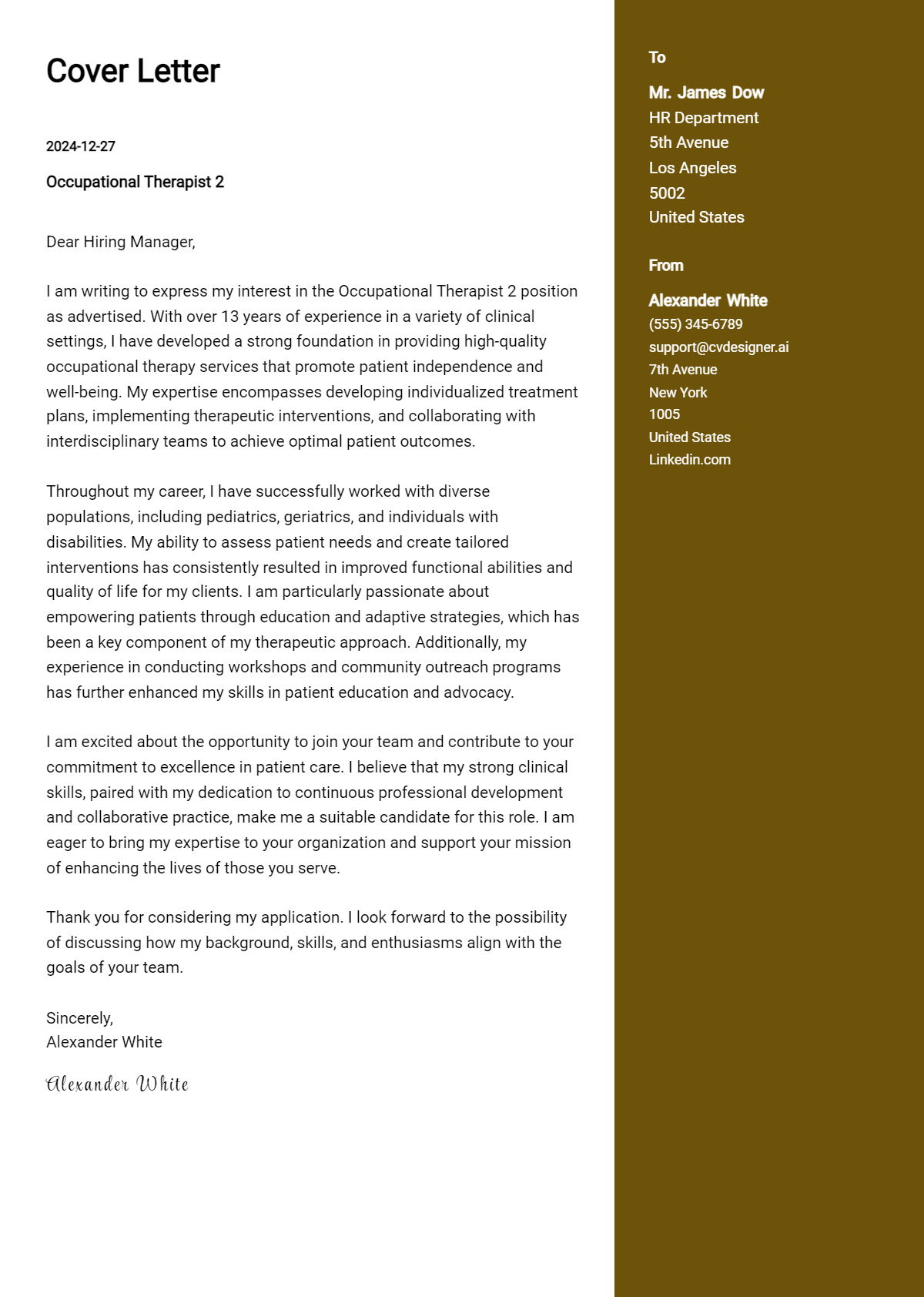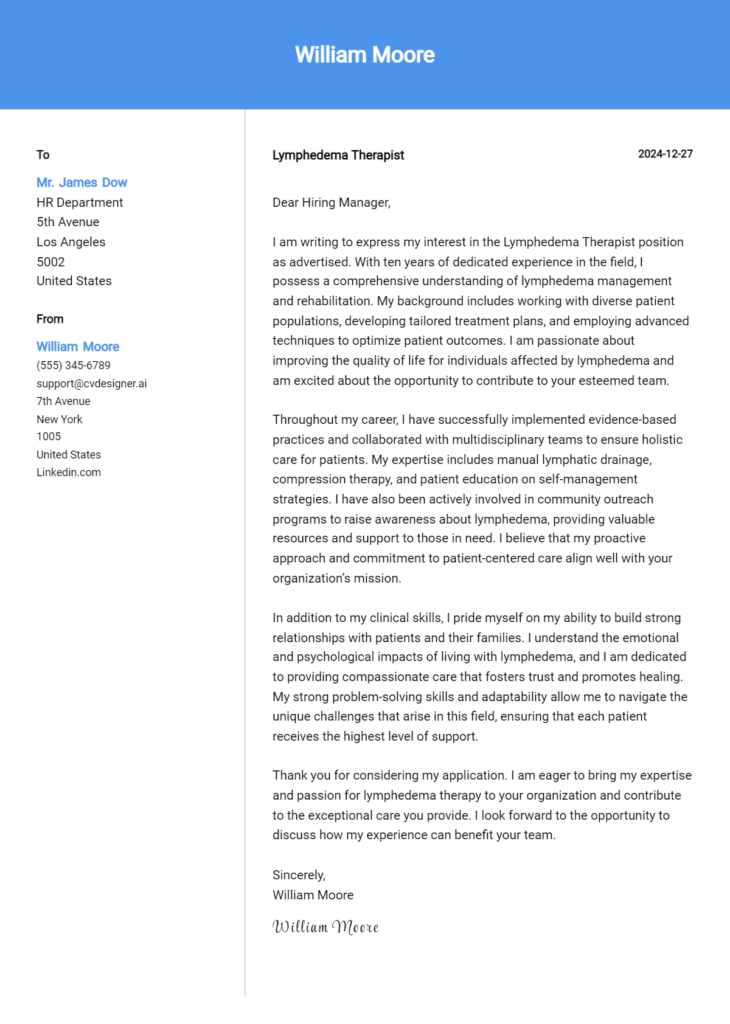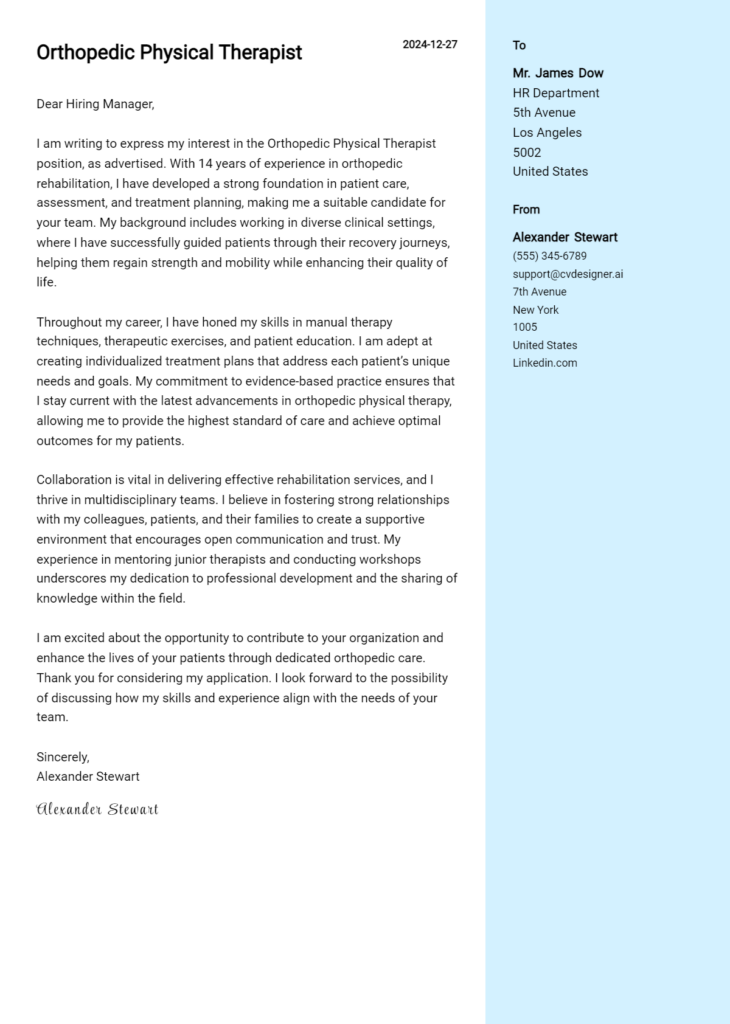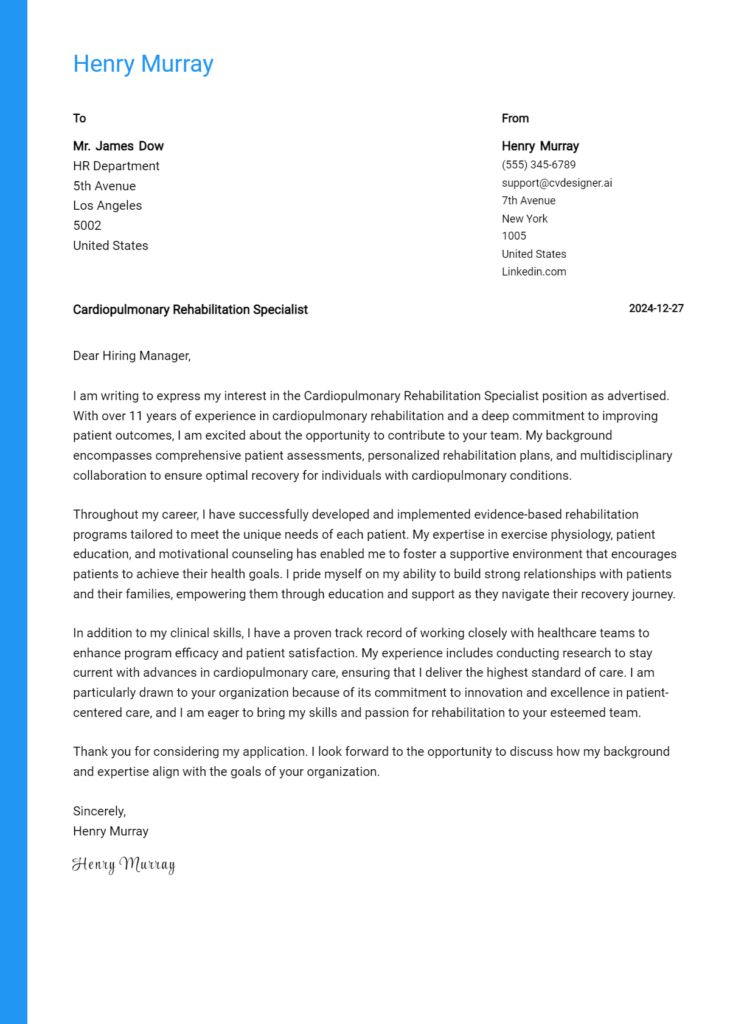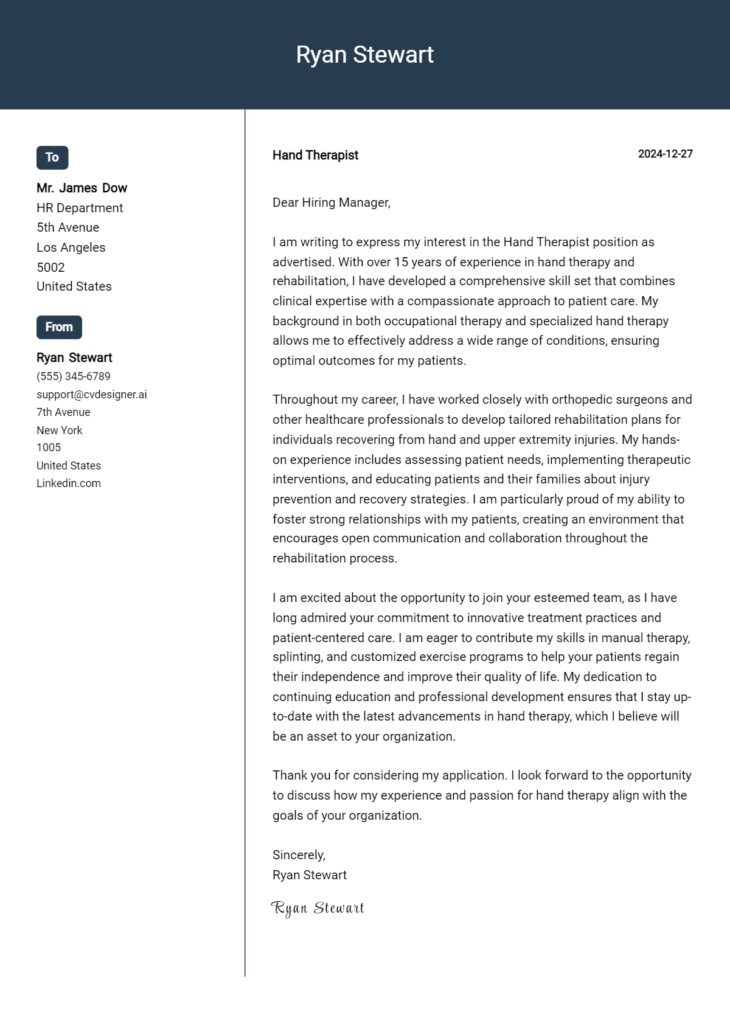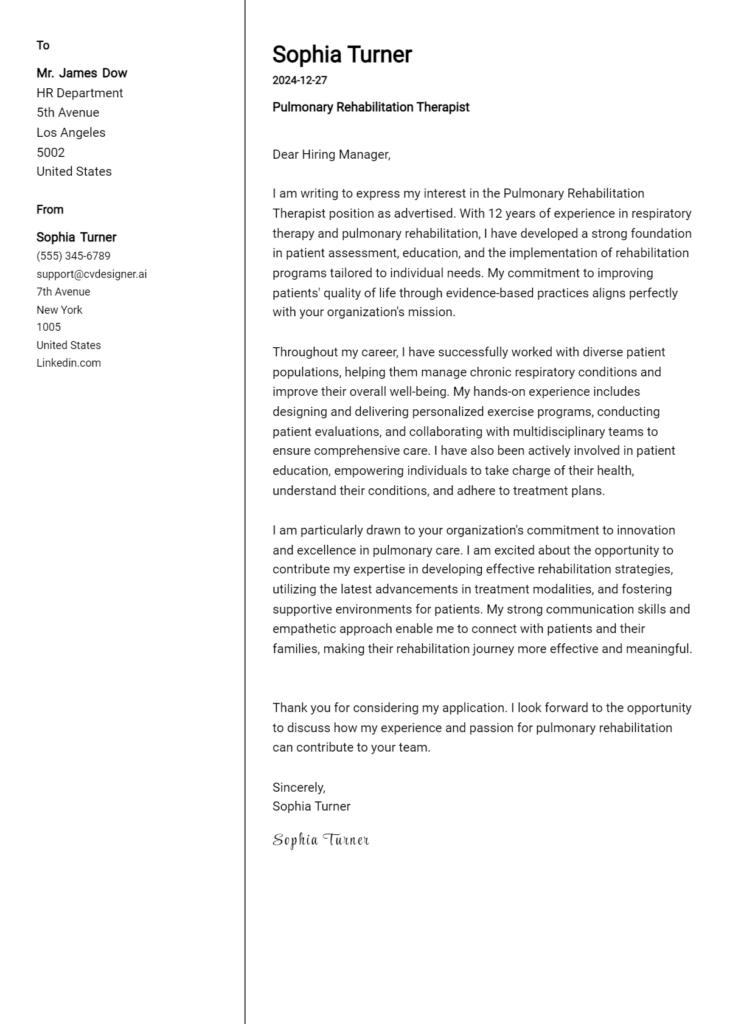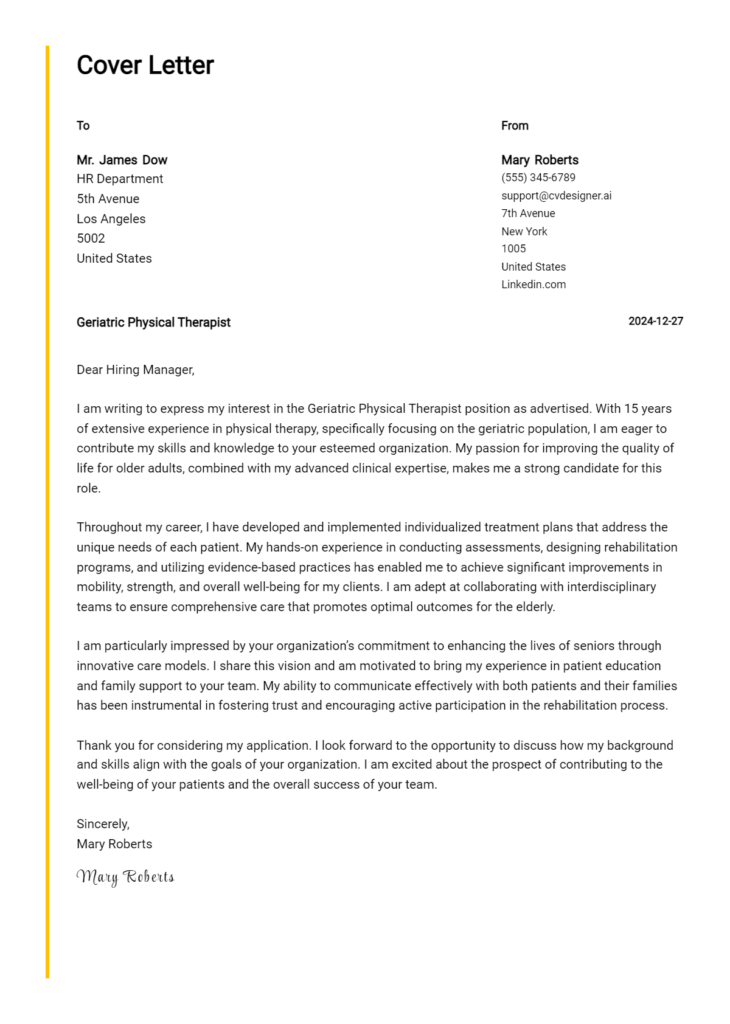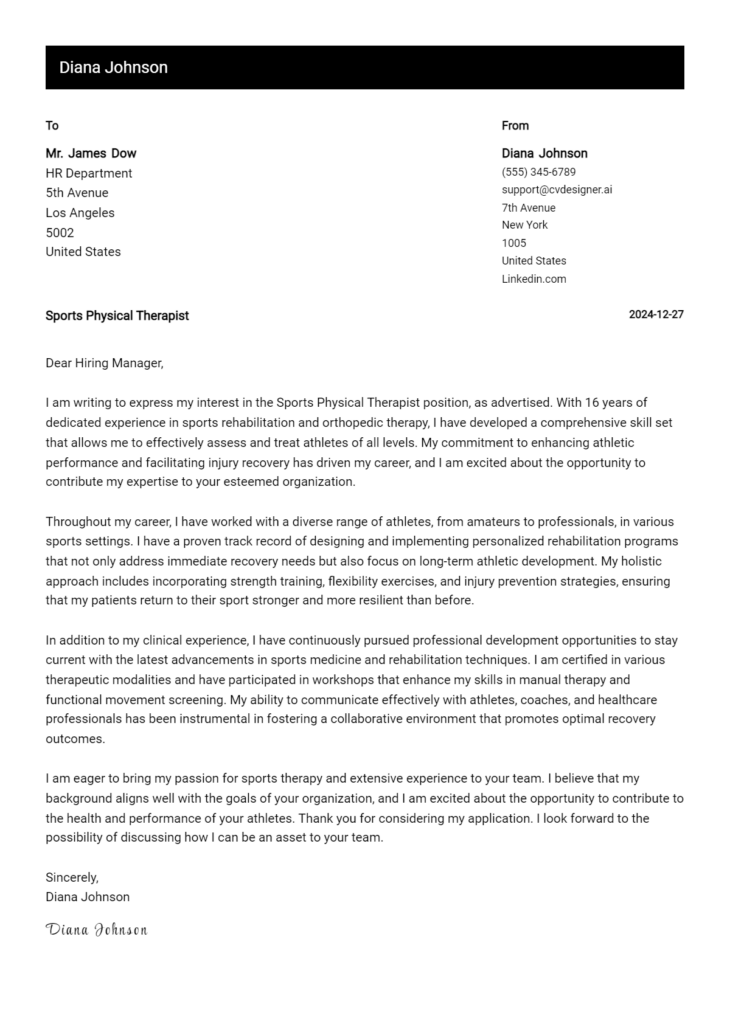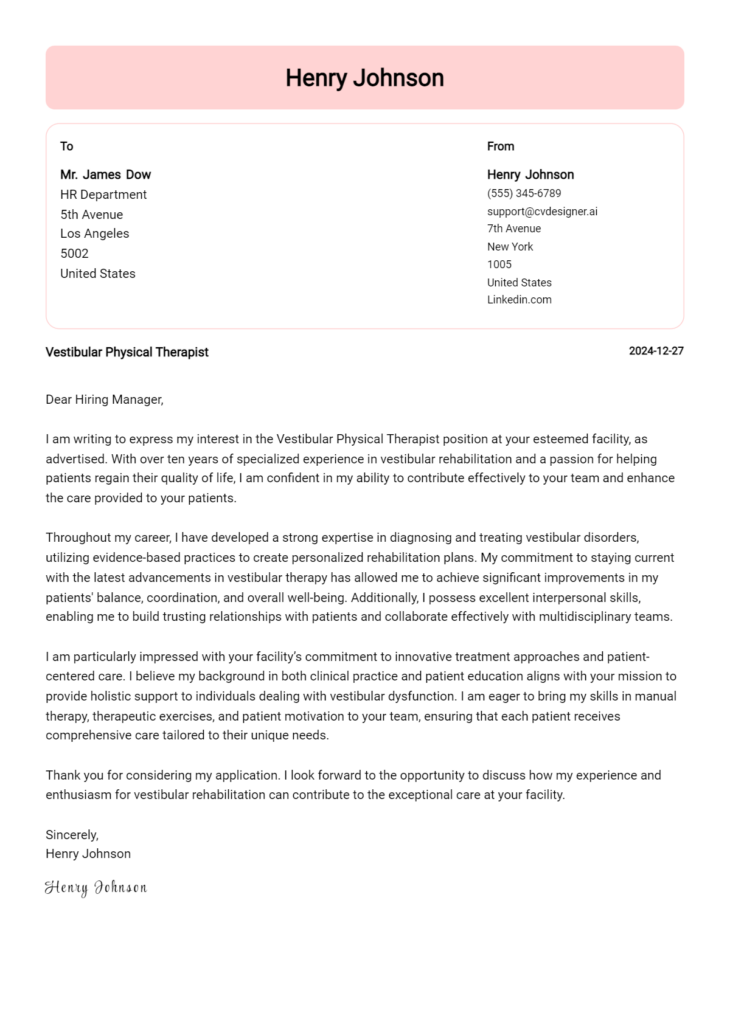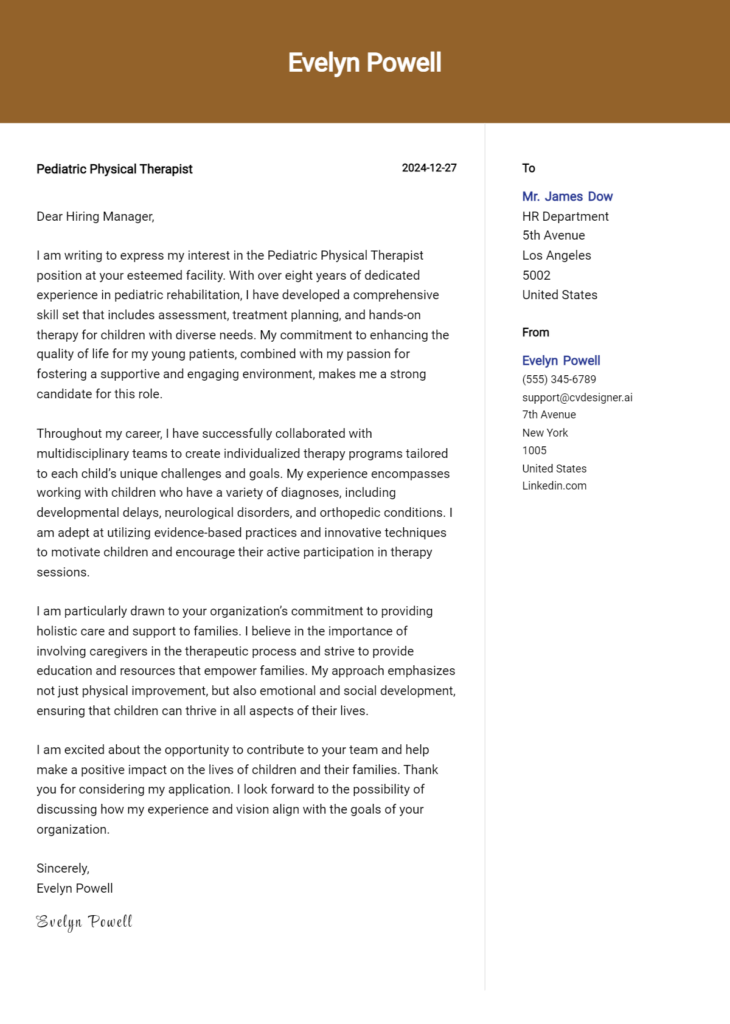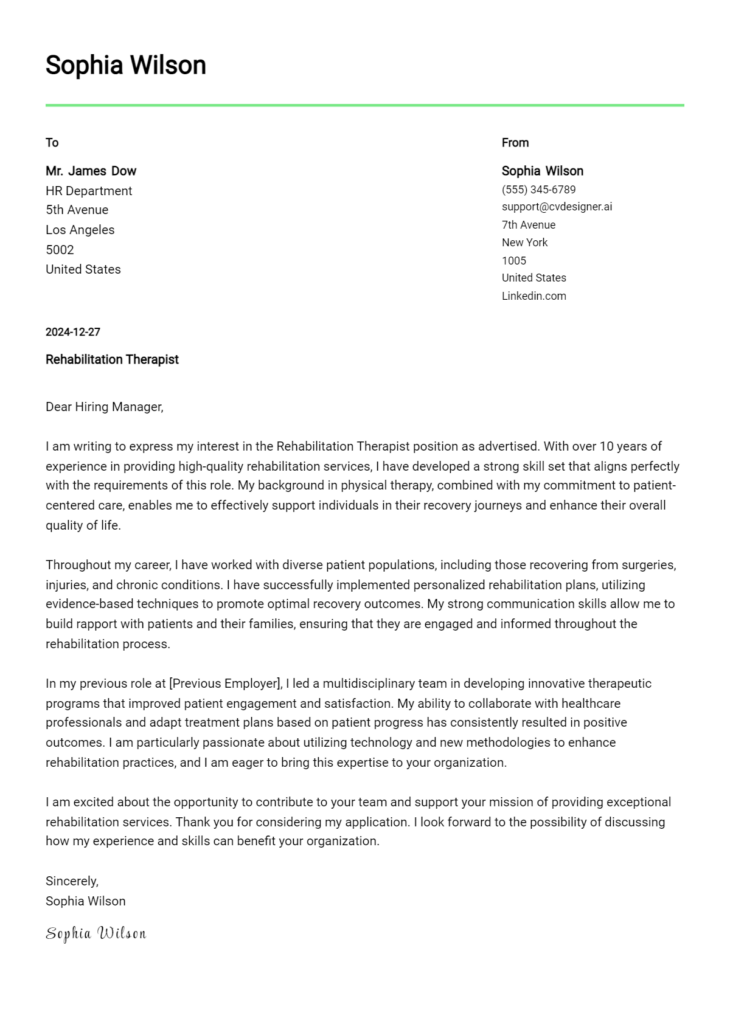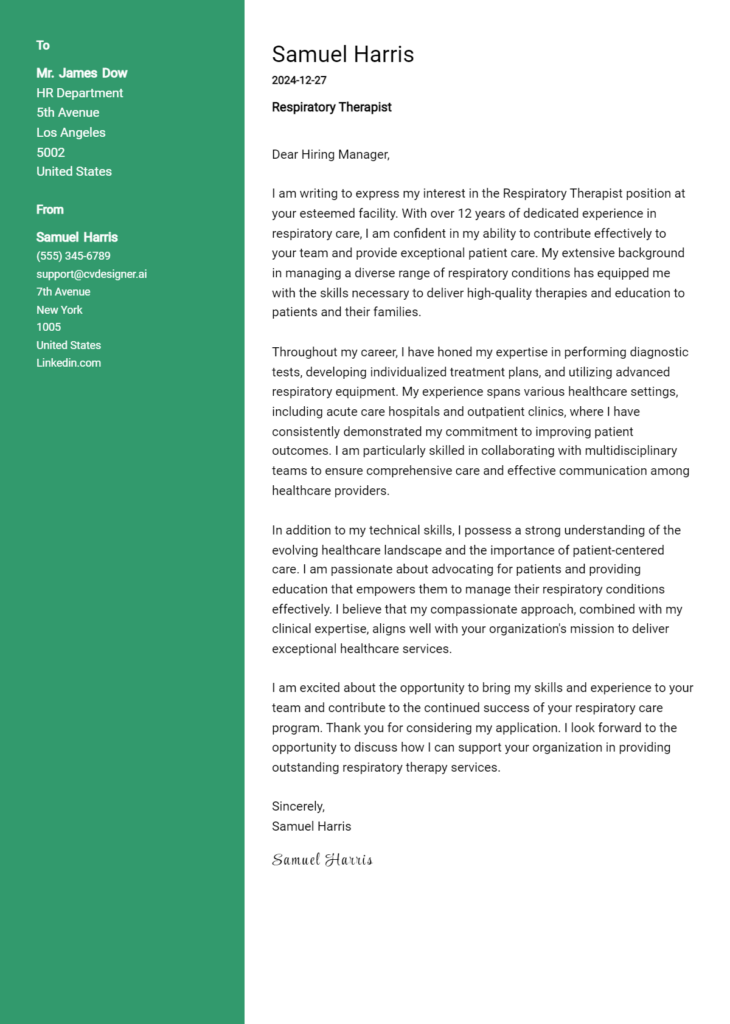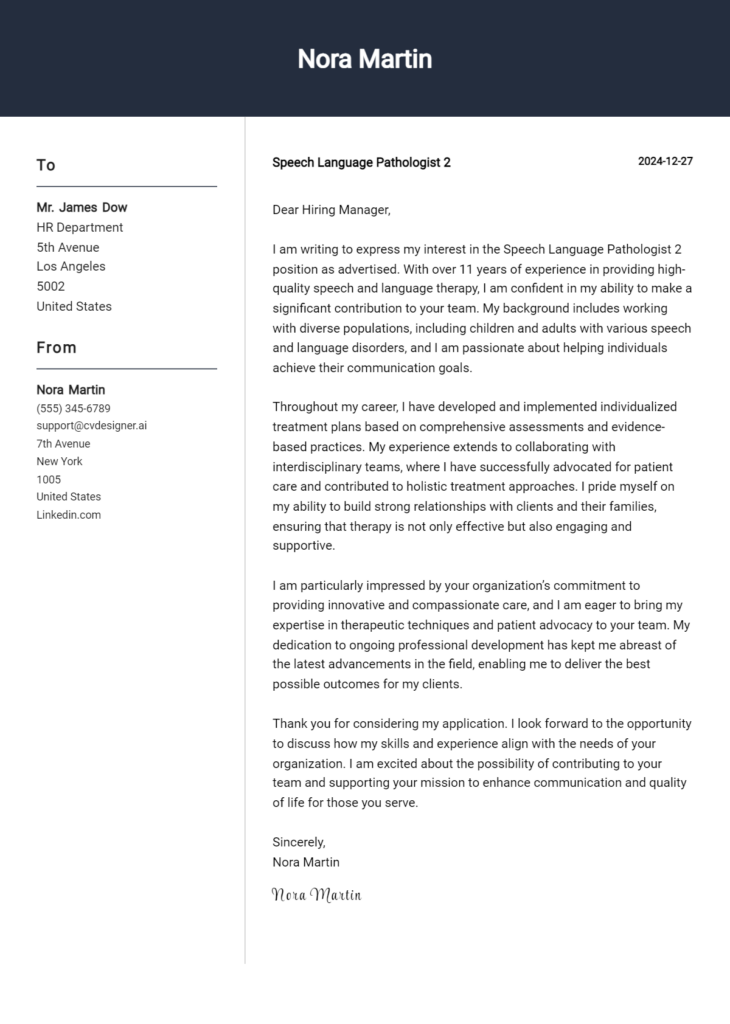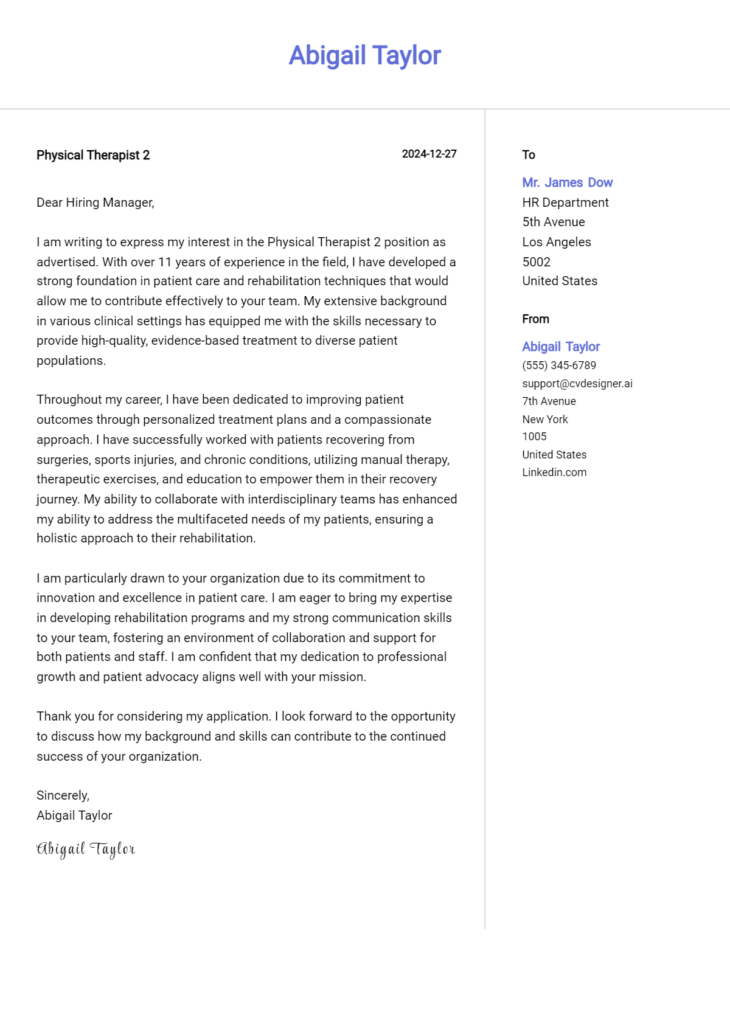Occupational Therapist 2 Cover Letter Examples
Explore additional Occupational Therapist 2 cover letter samples and guides and see what works for your level of experience or role.
How to Format an Occupational Therapist Cover Letter
Crafting a compelling cover letter is essential for occupational therapists, as it serves as your first opportunity to make a strong impression on potential employers. The format of your cover letter not only highlights your qualifications but also reflects your ability to communicate effectively—an essential skill in the field of therapy. A well-structured cover letter can effectively convey your understanding of patient needs and your commitment to improving their quality of life, which are critical attributes in occupational therapy.
In this guide, we will outline how to structure your cover letter, providing insights and occupational therapist-specific examples to help you create an impactful document.
We will focus on the essential components of a professional cover letter, including:
- Cover Letter Header
- Cover Letter Greeting
- Cover Letter Introduction
- Cover Letter Body
- Cover Letter Closing
Each section plays a vital role in showcasing your qualifications and professionalism. Let’s break down each part and explain how to make your occupational therapist cover letter stand out.
Importance of the Cover Letter Header for an Occupational Therapist
The cover letter header is a crucial component of any job application, particularly for an Occupational Therapist. It serves as the first impression that potential employers will have of an applicant, making clarity and professionalism vital. A well-structured header not only provides essential contact information but also establishes the applicant's attention to detail and organizational skills—qualities that are particularly important in the healthcare field. The header should include your name, address, phone number, and email, followed by the date and the recipient's details. This format ensures that the hiring manager can easily reach you and lends an air of professionalism to your application.
Strong Example
John Doe 123 Wellness Ave Health City, ST 12345 (555) 123-4567 johndoe@email.com October 1, 2023 Jane Smith Hiring Manager HealthCare Solutions 456 Care Blvd Health City, ST 12345
Weak Example
john doe health city 555-123-4567 johndoe@email 10/1/23 jane
In the strong example, the header clearly presents all necessary information in a well-organized manner, while the weak example lacks professionalism and clarity, making it less effective.
The Importance of the Cover Letter Greeting for Occupational Therapists
The greeting of your cover letter is more than just a formality; it sets the tone for the entire letter and establishes your professionalism right from the start. A well-crafted greeting not only demonstrates respect for the hiring manager but also conveys a sense of personalization that can make your application stand out. Directly addressing the hiring manager by name shows that you have taken the time to research the organization and are genuinely interested in the position. To avoid sounding generic, make an effort to find out the recipient's name, which can often be found on the company’s website, LinkedIn, or through a simple phone call.
Here are examples of strong and weak greetings for an Occupational Therapist cover letter:
Strong Greeting Example
Dear Ms. Johnson,
Weak Greeting Example
To Whom It May Concern,
The Importance of a Well-Crafted Cover Letter Introduction for an Occupational Therapist
A well-crafted cover letter introduction is crucial for Occupational Therapists seeking to make a lasting impression on hiring managers. This opening paragraph should not only capture the reader's attention but also succinctly express the candidate's enthusiasm for the role. By highlighting key skills or notable achievements right from the start, the introduction sets the tone for the rest of the letter and establishes the candidate's suitability for the position. An effective introduction can differentiate a candidate in a competitive job market, while a weak one may lead to missed opportunities.
Strong Example
Dear [Hiring Manager’s Name], As a dedicated Occupational Therapist with over five years of experience in diverse clinical settings, I am excited to apply for the Occupational Therapist position at [Company Name]. My strong background in developing personalized therapy plans and my commitment to enhancing patients' quality of life have empowered me to make a positive impact in my previous roles. I am particularly drawn to your organization because of its innovative approach to rehabilitation and its commitment to patient-centered care.
Weak Example
Hi there, I saw the job posting for an Occupational Therapist, and I think I would be a good fit. I have some experience in the field, and I hope my skills can be useful. I’m just looking for a job right now, and I would like to work at your place.
Purpose of the Cover Letter Body for an Occupational Therapist
The body of a cover letter for an Occupational Therapist serves as a critical platform for candidates to articulate their professional journey, showcasing their skills, experiences, and the unique value they bring to a potential employer. It allows applicants to highlight specific projects or accomplishments that demonstrate their expertise in facilitating patient recovery and enhancing quality of life. Through this narrative, candidates can connect their qualifications to the needs of the organization, illustrating how they can contribute to the team and improve patient outcomes.
Strong Example
Dear Hiring Manager, I am excited to apply for the Occupational Therapist position at XYZ Rehabilitation Center. With over five years of experience working in diverse clinical settings, I have successfully developed and implemented individualized treatment plans that led to a 30% improvement in patient mobility and function among my caseload. One notable project involved collaborating with a multidisciplinary team to create a community-based program focusing on stroke recovery, which not only enhanced patient engagement but also increased our referral rates by 40%. I am eager to bring my skills in patient assessment and therapeutic interventions to your esteemed team, and I am dedicated to fostering an environment that prioritizes holistic recovery. Sincerely, [Your Name]
Weak Example
Dear Hiring Manager, I am applying for the Occupational Therapist job. I have worked in this field for a few years and have helped some patients. I think I would be a good fit for your team because I am a hard worker. I have done some projects, but I don't remember the details. I hope to bring my experience to your clinic and help patients. Best, [Your Name]
Importance of Cover Letter Closing for an Occupational Therapist
The closing paragraph of a cover letter is crucial for an Occupational Therapist as it summarizes your qualifications, reiterates your enthusiasm for the position, and encourages the hiring manager to take the next steps, such as reviewing your resume or scheduling an interview. A strong closing leaves a lasting impression, while a weak one may fail to convey your genuine interest in contributing to the team. Here's how to effectively close your cover letter:
Strong Example
Thank you for considering my application for the Occupational Therapist position at [Company Name]. With my extensive experience in developing tailored treatment plans and my passion for improving patient outcomes, I am excited about the opportunity to contribute to your team. I look forward to the possibility of discussing how my skills align with the needs of your patients. Please feel free to review my resume, and I hope to schedule an interview soon to further explore how I can make a positive impact at [Company Name].
Weak Example
Thanks for looking at my letter. I guess my experience is okay, and I think I would be a decent fit. If you want to talk, that would be fine, I guess. You can look at my resume whenever you have time.
These tips are designed to help candidates create an impactful cover letter tailored for an Occupational Therapist position. A well-crafted cover letter not only showcases your technical skills and problem-solving abilities but also highlights your knowledge of the service delivery and lifecycle (SDLC), your ability to work effectively in teams, and your dedication to continuous learning. By emphasizing these qualities, you can differentiate yourself from other applicants and demonstrate your commitment to the field.
Tips for Crafting an Effective Occupational Therapist Cover Letter
Highlight Relevant Technical Skills
Begin your cover letter by showcasing your technical skills that are pertinent to occupational therapy. This could include your proficiency in rehabilitation techniques, knowledge of assistive technologies, or familiarity with specific therapeutic modalities. Use specific examples to illustrate how these skills have positively impacted your patients in the past.Demonstrate Problem-Solving Abilities
Occupational therapists often face unique challenges with each patient. In your cover letter, share a specific instance where you effectively resolved a complex issue or adapted a treatment plan to meet a patient's needs. This highlights your critical thinking and problem-solving skills, which are essential for success in this role.Showcase SDLC Knowledge
Understanding the service delivery and lifecycle (SDLC) in occupational therapy is crucial. Briefly explain your experience with assessment, treatment planning, implementation, and evaluation phases. Mention any tools or methodologies you use to track patient progress, which can demonstrate your organizational skills and attention to detail.Emphasize Teamwork and Collaboration
Collaboration with other healthcare professionals is vital in occupational therapy. Discuss your experience working within multidisciplinary teams and how you contributed to shared goals. Highlight your ability to communicate effectively, resolve conflicts, and support your colleagues, which underscores your teamwork capabilities.Express Passion for Continuous Learning
The field of occupational therapy is constantly evolving, and a commitment to continuous learning is essential. Mention any relevant certifications, workshops, or courses you have completed to stay updated on best practices. This reflects your dedication to professional development and enhances your appeal to potential employers.
By following these tips, you can create a compelling cover letter that stands out to hiring managers. For additional resources, consider utilizing cover letter templates or a cover letter builder to streamline the process and ensure a polished final product.
Common Mistakes to Avoid in an Occupational Therapist Cover Letter
Crafting a compelling cover letter is essential for standing out in the competitive field of occupational therapy. Avoiding common pitfalls can significantly enhance your chances of landing an interview. Here are some frequent mistakes to watch out for when writing your cover letter, along with tips on how to steer clear of them:
Generic Greetings: Using a vague salutation like "To Whom It May Concern" can make your letter feel impersonal. Tip: Address the letter to a specific hiring manager if possible to create a more personalized connection.
Lack of Specificity: Failing to mention why you are specifically interested in the position or organization can weaken your application. Tip: Research the company and tailor your letter to reflect your passion for their mission and values.
Repetition of Resume: Simply reiterating what is on your resume without adding new insights can make your cover letter redundant. Tip: Use the cover letter to highlight your key achievements and explain how they align with the job requirements.
Ignoring the Format: A poorly formatted cover letter can distract from your message. Tip: Follow a professional cover letter format to ensure clarity and readability.
Spelling and Grammar Errors: Typos and grammatical mistakes can convey a lack of attention to detail. Tip: Proofread your letter multiple times and consider asking someone else to review it.
Too Lengthy: An overly long cover letter can lose the reader's interest. Tip: Aim for a concise letter that is no longer than one page, focusing on the most relevant information.
Neglecting a Call to Action: Failing to express your desire for further discussion can leave your letter feeling unfinished. Tip: Conclude with a strong call to action, inviting the employer to contact you for an interview.
By steering clear of these common mistakes, you can create a more effective cover letter that showcases your qualifications as an occupational therapist. For more insights, check out cover letter examples.
Cover Letter FAQs for Occupational Therapist
What should I include in my cover letter as an Occupational Therapist?
Your cover letter should highlight your qualifications, experience, and passion for occupational therapy. Start with a compelling introduction that states the position you're applying for and briefly explains why you're a good fit. Include specific examples of your clinical skills, such as experience with various patient populations or therapeutic techniques. Highlight any specialized training or certifications, and discuss your ability to develop personalized treatment plans. Additionally, convey your enthusiasm for the position and the organization, emphasizing how your values align with theirs. Finally, conclude with a strong statement that invites further discussion and expresses your eagerness for an interview.
How can I make my cover letter stand out?
To make your cover letter stand out, personalize it for the specific job and organization. Research the company’s mission, values, and recent achievements, and incorporate this information to demonstrate your genuine interest. Use quantitative data to showcase your accomplishments, such as improving patient outcomes or increasing client satisfaction rates. Employ a professional yet engaging tone, and avoid generic phrases. Additionally, share a brief narrative about a memorable patient interaction that demonstrates your empathy and problem-solving skills. Finally, ensure that your letter is well-structured and free of grammatical errors, as professionalism is key in healthcare settings.
Should I include my resume details in my cover letter?
While your cover letter should complement your resume, it should not simply repeat the same information. Instead, use the cover letter to elaborate on key experiences and skills that are particularly relevant to the job. Focus on specific examples that highlight your clinical expertise, interpersonal skills, and ability to work in a team. For instance, if you have experience with a specific therapy technique or population, explain how that experience equips you for the role you’re applying for. The goal is to provide context and personal insights that can’t be captured in a resume format.
How long should my cover letter be?
Your cover letter should typically be one page long, ideally consisting of three to four paragraphs. This length allows you to convey important information without overwhelming the reader. Aim for clarity and conciseness, using direct language to express your qualifications and enthusiasm for the role. Each paragraph should serve a purpose: an engaging introduction, a detailed discussion of your relevant skills and experiences, and a strong conclusion that reiterates your interest and invites further dialogue. Remember to keep your formatting clean, with proper spacing and professional fonts, to ensure readability.
Build your Cover Letter in minutes
Use an AI-powered cover letter builder and have your letter done in 5 minutes. Just select your template and our software will guide you through the process.

